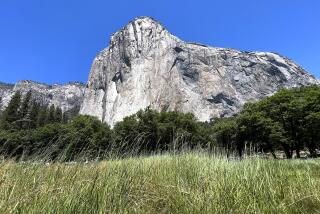FAA to Limit Air Tours Over Grand Canyon
- Share via
DENVER — The Federal Aviation Administration on Tuesday announced new rules aimed at reducing noise caused by air tours of the Grand Canyon, part of a decades-long effort to return the national park to its state of “natural quiet.”
The wide-ranging regulations for the first time limit the number of annual flights allowed and significantly modify the routes that small planes and helicopters may take over the canyon. The park’s “no-fly zone” would be increased to include 75% of the parkland, compared with the current 45%, and would cover parts of the Hualapai and Havasupai Indian reservations.
The number of flights would be capped at present levels--about 88,000 sightseeing flights per year--starting in about a month. The other changes will be phased in starting at the end of the year.
Air tours have been an increasingly popular way to visit the canyon, with the number of flights nearly tripling since 1987. Park Supt. Rob Arnberger said in a statement that, before the FAA decision, air tour visitors were the only “specialized” park visitors whose numbers were not restricted. The number of river rafters, mule riders and overnight campers is limited.
“Although the impacts may be different than those caused by visitors on the ground, air tourism and air tour aircraft-produced noises have significant resource and environmental impacts,” he said.
The FAA rules are the latest response to a 1987 law sponsored by Sen. John McCain (R-Ariz.) mandating the park service to reduce noise at the park. Already the park prohibits tour buses from idling at scenic overlooks and has encouraged river raft tour boats to switch from four-cycle to two-cycle engines; the park’s own helicopter is now a state-of-the-art MD900, which has exhaust ports in place of a tail rotor. A mass transit plan that severely restricts private automobiles already is in place.
Sightseeing flight companies had acknowledged the need for some restrictions, but charged that the new rules could put them out of business and deprive visitors of the opportunity to see the canyon by air.
“If this rule is implemented in the Grand Canyon, it will have a devastating effect on these companies and a devastating effect on the 20% of people visiting the Grand Canyon who do so by air,” said Steve Bassett of the U.S. Air Tour Assn.
Environmental groups had pushed for even stricter regulations and some said Tuesday’s announcement didn’t go far enough.
The first air tour of the Grand Canyon was recorded in February 1929, six months before the area was designated a national park. The park, in northern Arizona, became more accessible with the construction in 1967 of an airport near the south entrance and even more so with service from four airports in Las Vegas.
Canyon tour flights were unregulated until 1987, when a twin-engine plane and a helicopter collided in midair, killing 25 sightseers. According to Ken Weber, a parks service official who is preparing the Grand Canyon’s noise management plan, before that accident no flight plans were filed by tour operators, and pilots were free to fly anywhere over the park.
Weber said the park’s goal is by 2008 to restore natural quiet to 50% of the park, 75% of the time. The sounds of nature--without the hum of motors or even human voices--constitute natural quiet, Weber said.
More to Read
Sign up for The Wild
We’ll help you find the best places to hike, bike and run, as well as the perfect silent spots for meditation and yoga.
You may occasionally receive promotional content from the Los Angeles Times.







